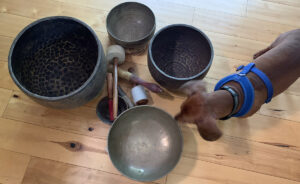 Post election we need deep relaxation, pain relief, digestive help, cure for migraines, repaired immune system, elimination of toxins (too much wine), and better concentration. I thought this the time for an article on JF’s “singing” bowls from his home altar. His collection includes Japanese standing “struck” bowls, one quite large at twelve inches and one nine and a half inches.
Post election we need deep relaxation, pain relief, digestive help, cure for migraines, repaired immune system, elimination of toxins (too much wine), and better concentration. I thought this the time for an article on JF’s “singing” bowls from his home altar. His collection includes Japanese standing “struck” bowls, one quite large at twelve inches and one nine and a half inches.
The hand hammered (repousse) pattern of little circles and a blessing in characters around the rim make Japanese standing bowls distinctive. JF passes his altar and taps periodically to feel the “improvements” listed above for good physiological and scientific reasons.
His Collection is Valuable
Who first discovered the healing properties of such bowls? Why have people struck them for thousands of years for both spiritual and therapeutic healing?
Ancient people discovered healing properties of sound produced by bells and bowls 12,000 years ago, according to archaeological finds. The modern theory says sound balances both sides of the brain via vibrations of a certain frequency. Since we now have “discovered” DNA, proponents of “the sound bath” say the “ommmmmm” of the bowl/bell “awakens” DNA. Some say the right sound “awakens” the adrenal gland. Terms like “DNA” were unknown back in the day. A way of thinking was that sound balanced the astral channels (chakras).
Musicologists measured perfectly crafted bowls producing frequencies about 4-6 kHz. Perhaps the ancient craftsmen who created these bowls witnessed the effects sound made on people and used that as their scientific ‘proof.’
The first singing bowls were made of pure copper 5,000 years ago in Mesopotamia. The brass/bronze bowl technology came later. Also thousands of years old, they arrived in Tibet from India about the same time India introduced Tibet to Buddhism (8th C AD). You might partially fill singing bowls with water. A Chinese form called a spouting bowl comes with handles which when rubbed causes sound that makes water droplets leap, used since the 5th century BCE.
Our Brains Produce Electromagnetic Waves:
In the brain’s normal conscious state, waves are ‘beta,’ in deep sleep, “delta,” yet in mediation, brains produce beneficial “alpha” waves. When such bowls are “tuned” right, the sound helps the brain produce Alpha waves.
Physician Hans Jenny (d 1972) pioneered the study of sound in therapy, called modal vibration studies. He discovered that when the brain hears certain types of sound, Alpha waves are detected on an electroencephalogram (EEG).
Singing bowls actually sing because the sound lasts longer than the strike or rub to the bowl’s rim. The classic is a bowl where the mallet is rotated around the rim as opposed to the striking bowl. Both vibrate, as JF’s dog might tell us as he cocks his head to the sound in that picture.
Such bowls are used in Buddhist chants and mediations historically assisted by sound from struck standing bowls/bells. Originating in China, some of the oldest bronze objects that “sing” are goblet shaped iron bells, found in groups of sizes (5th millennium BCE). These bells represent advanced technological skill in acoustics and metallurgy. The mallet-struck bell reached its finest expression in China and Japan. A pair of folk musicians introduced the West to the Tibetan singing bowl in 1972, the predominate geographical marketplace today.
A Singing Bowl is a Musical Instrument
They’re classified as an “struck idiophone,” meaning the whole of the object, without any other element, is the whole instrument, as the whole of the bell vibrates. People that play the spoons also play struck idiophones. By the way, once your singing bowl starts to buzz, reaches maximum volume and left to resonate, you should not “play” it further. The bowl can shatter. Maximum vibration occurs around the rim of the bowl, which echoes around the whole of the open bowl. That’s where the engineering marvel happens. When a bowl is crafted correctly, the sound erases the tensions of November 2024.
JF’s bells are made of “bell metal,” a classic alloy of copper and tin, cast as molten metal, and then hand hammered into shape. The Japanese name for his bowls are Namarin, but if the largest of the two were any bigger, up to three feet, that’s a temple bell called Daikin. The value of the pair of largest singing bowls is significant, as both are late 19th early 20th century, $2,800.
Pingback: Crystal Singing Bowl in G# - Elizabeth Appraisals